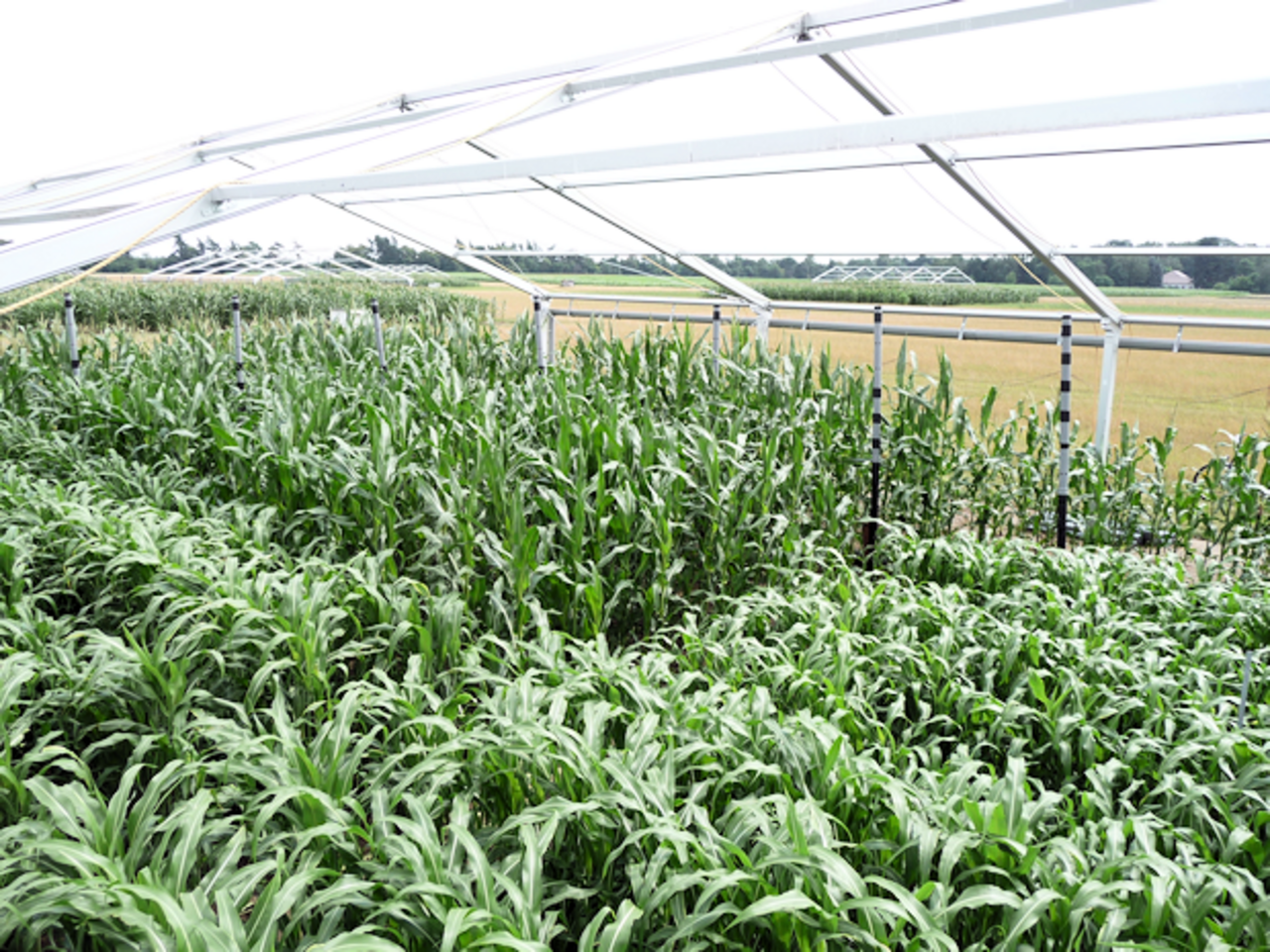Project
Climate change: more advantageous for sorghum or maize

Screening of Sorghum-genotypes in terms of growth and resource use efficiency under future climatic conditions
For to ensure an efficient plant biomass production in the future, the climatic changes as predicted by the IPCC, i.e. increase in atmospheric CO2 concentration, temperature and summer drought, has to be considered. Currently, the C4 crop maize has the greatest biomass yield and is the mostly used energy crop. Sorghum has also C4-photosynthesis and a similar growth habit but is better to warm sites and has a higher drought tolerance as compared to maize. at present there are efforts to grow sorghum as an alternativ to maize for to extend crop rotation and shift the area for cultivation to marginal land to reduce the competition for land between food and energy production.
Background and Objective
In this project the tolerance of different Sorg¬hum genotypes and maize to drought under elevated CO2 concentrations will be investigated. Total biomass production will be measured and resource use and use efficiency of radiation and water. In this way it will be investigated, whether genotypes differ in biomass production and which process is responsible for that.
Approach
Plants will be grown on an experimental field under different CO2 and watering conditions by using the FACE-technique
Data and Methods
Biomass production will be measured and the use of the resources radiation and water and finally the resource use efficiencies will be calculated.
Our Research Questions
Who has a higher biomass production under optimum and water limited growing conditions, maize or sorghum?
Who profits more from the increase of the CO2 concentration under summer drought, sorghum or maize?
Results
Maize has a higher growth potential as compared to Sorghum and this necessarily leads to a high water demand of the plant and the water savings under CO2 enrichment can be transformed in additional biomass production. So, current cultivars of maize are superior to current sorghum cultivars even on marginal land and under elevated CO2 concentrations.
Involved external Thünen-Partners
- Deutscher Wetterdienst (DWD)
(Offenbach, Deutschland) - Christian-Albrechts-Universität zu Kiel
(Kiel, Deutschland) -
Universität Rostock
(Rostock, Deutschland) -
Leibniz Universität Hannover
(Hannover, Deutschland) - Julius Kühn-Institut - Bundesforschungsinstitut für Kulturpflanzen (JKI)
(Quedlinburg, Braunschweig, Groß Lüsewitz, Kleinmachnow, Deutschland)
Funding Body
-
Federal Ministry of Education and Research (BMBF)
(national, öffentlich)
Duration
4.2009 - 12.2012
More Information
Project funding number: FKZ 0315421D
Project status:
finished
Publications
- 0
Oldenburg E, Manderscheid R, Erbs M, Weigel H-J (2015) Anstieg des CO2-Gehaltes in der Atmosphäre und Sommertrockenheit: Auswirkungen auf den Deoxynivalenol-Gehalt in Mais und Hirse? J Kulturpfl 66(6):217-218
- 1
Manderscheid R, Erbs M, Weigel H-J (2015) Key physiological parameters related to differences in biomass production of maize and four sorghum cultivars under drought and free air CO2 enrichment. Proced Environ Sci 29: 89-90, DOI:10.1016/j.proenv.2015.07.174
- 2
Manderscheid R (2014) Energiepflanzen im Klimawandel: Sorghum - konkurrenzfähig mit Mais? Pflanzenarzt 67(5):27-29
- 3
Manderscheid R (2014) Klimawandel: Vorteil Mais oder Sorghum? : Wie wirken sich unterschiedliche Wasserversorgung und atmosphärische CO2-Konzentrationen auf das Wachstum aus? Mais 41(1):22-25
- 4
Weigel H-J, Manderscheid R, Fangmeier A, Högy P (2014) Mehr Kohlendioxid in der Atmosphäre: Wie reagieren Kulturpflanzen? [online] In: Lozán JL, Graßl H, Karbe L, Jendritzky G (eds) Warnsignal Klima : Gefahren für Pflanzen, Tiere und Menschen . 2. Aufl. , zu finden in <http://www.klima-warnsignale.uni-hamburg.de/wp-content/uploads/2014/04/weigel.etal.pdf> [zitiert am 12.01.2015]
- 5
Manderscheid R, Erbs M, Weigel H-J (2013) Ecophysiological traits related to the growth response of maize and sorghum to drought and free air CO2 enrichment. In: Building bridges in ecology : linking systems, scales and disciplines ; GfÖ 43rd Annual Meeting of the Ecological Society of Germany, Austria and Switzerland ; September 9 to 13, 2013, Potsdam, Germany ; book of abstracts. Göttingen: Gesellschaft für Ökologie, p 23
- 6
Erbs M, Manderscheid R, Weigel H-J (2012) A combined rain shelter and free-air CO2 enrichment system to study climate change impacts on plants in the field. Methods Ecol Evol 3(1):81-88, DOI:10.1111/j.2041-210X.2011.00143.x
- 7
Erbs M, Manderscheid R, Burghardt B, Duensing R, Fiedler K, Burghardt B, Weigel H-J (2012) Auswirkung erhöhter atmosphärischer CO2-Konzentrationen auf den Wasserhaushalt von Mais und Sorghum-Hirse. Mitt Gesellsch Pflanzenbauwiss 24:275-276
- 8
Manderscheid R, Erbs M, Weigel H-J (2012) Effects of free air CO2 enrichment and drought on canopy development and biomass production of different sorghum genotypes as compared to maize. In: Stoddard FL (ed) 12th Congress of the European Society for Agronomy : abstracts ; Helsinki, Finland, 20-24 August 2012. Helsinki, pp 234-235
- 9
Manderscheid R, Erbs M, Weigel H-J (2012) Vergleichende Untersuchung zur Wirkung erhöhter CO2-Konzentration und Trockenheit auf das Wachstum von Sorghum-Hirse und Mais. Mitt Gesellsch Pflanzenbauwiss 24:146-147
- 10
Manderscheid R, Erbs M, Weigel H-J (2011) Untersuchung zur Wechselwirkung unterschiedlicher CO2-Konzentrationen und Wasserversorgung auf das Wachstum von Mais und Sorghum-Hirse. Mitt Gesellsch Pflanzenbauwiss 23:168-169
- 11
Manderscheid R, Erbs M, Weigel H-J (2011) Vergleichende Untersuchung zur Wirkung erhöhter atmosphärischer CO2-Konzentrationen auf die Stomatadichte bei Mais und Sorghum-Hirse. Mitt Gesellsch Pflanzenbauwiss 23: 167

![[Translate to English:] [Translate to English:]](/media/_processed_/4/0/csm_Titel_Ant_Plot_1c3363e3f7.png)
![[Translate to English:] [Translate to English:]](/media/_processed_/b/3/csm_Titel_93px_Ant_Plot_0ef6a20d79.png)
![[Translate to English:] Logo des Bundesministerium für Ernährung und Landwirtschaft](/media/allgemein/logos/BMEL_Logo.svg)